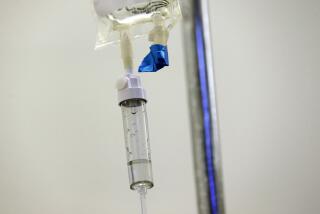ICN Seeks an Edge in Russia by Boosting Local Production
- Share via
Alexander Savrosov searched three Moscow pharmacies before finding an imported heart drug for his wife. The drug, widely available last summer, became scarce after Russia’s ruble began a 70% fall against the dollar.
When Savrosov, 65, finally found the medication at a central Moscow pharmacy, the price of the pills had tripled, to about a third of his 380-ruble ($18) monthly state pension.
He bought it anyway. “I’m desperate,” he said.
Savrosov’s dilemma is not unique, and may not last long. While the ruble’s plunge forced Eli Lilly & Co., Merck & Co. and other international drug makers to raise prices to uncompetitive levels, local producers are stepping in to grab bigger shares of Russia’s estimated $3 billion drug market by offering generic drugs at as little as one-tenth the price of brand-name pharmaceuticals.
ICN Pharmaceuticals Inc. of Costa Mesa has recognized that the only way to survive in Russia is to expand local production and distribution of drugs, including those it makes under license from Lilly, Roche Holding AG, Schering-Plough Corp. and Bristol-Myers Squibb Co.
“Big multinationals have no chance in the world here now,” said Brian Coleman, an analyst at Moscow brokerage Aton. “What they sell is too expensive. Once the economy turns around again, foreign producers in Russia will be in a good position.”
Until the end of the Soviet era in 1990, Russia mainly made base chemicals for Eastern European drug makers such as Gedeon Richter. In the last eight years, foreign companies turned Russian plants into full drug factories to tap the local market of 250 million people, each of whom spends about $10 per year on medication. By contrast, the average American spends about $300 a year on prescription drugs.
ICN and other local producers haven’t escaped Russia’s economic woes: Like their competitors, they lost money when banks failed and lost customers when credit dried up. In the long term, however, analysts said domestic drug makers with foreign financing should be the first to rebound because their costs are lower and they don’t pay import duties.
“If there is any activity in the market, it will favor locals,” said Hector Forsythe, an analyst at Paribas Capital Markets in London. “Anyone with ruble-based production will be at an advantage.”
The potential for growth is considerable. Not only do Russians not yet buy many drugs, but two-thirds of the drugs they do buy are imports. Some drugs, including insulin, are not made locally at all.
Monsanto Co. of the United States began a joint venture with Russia’s Biopreparat and the Russian Center for Molecular Diagnostics and therapy in 1996 to build a biopharmaceutical factory near Moscow. The production facilities are being completed and are due to begin operating next year, according to a report by RZB Austria.
For now, the market is tough. Sales of imported drugs fell 30% since Russia in August devalued the ruble, according to the Assn. of International Pharmaceutical Manufacturers, which represents 54 drug importers. Sales are expected to fall 60% the first half of this year, said David Kennedy, AIPM’s director.
Until the retail market rebounds, drug makers are competing to get their products on a government list of “essential” drugs that are distributed by the government free of charge or at a discount. Getting on the list means guaranteed sales to the government.
The cash-strapped government, though, is considering price controls on essential medicines, a move that could slash profits. It already requires drug makers to submit a list of their prices and limits distributors’ markups.
Companies, even those with local plants, are cautious.
ICN, Eastern Europe’s biggest drug maker, shuttered its five Russian plants for a month after demand slumped. ICN said it also put on hold plans to buy two more plants in Russia.
More to Read
Inside the business of entertainment
The Wide Shot brings you news, analysis and insights on everything from streaming wars to production — and what it all means for the future.
You may occasionally receive promotional content from the Los Angeles Times.










